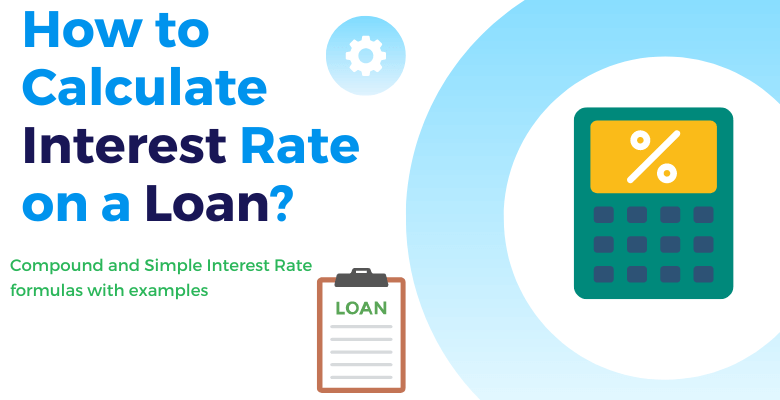
Want to crack the code on loan interest calculation mysteries? Allow us to crack this code for you.
If you are a step away from taking Instant Personal Loans or borrowing some money, understanding the computation of interest can save you tons. Yes, it really can save you money and change the game in minutes.
The loan interest can affect the total amount you will repay over time. It can even help you determine whether a loan is affordable. In this article, we will clarify all the complex procedures involved in calculating loan interest and empower you to make informed financial decisions. So let’s get started!
How is Loan Interest Calculated?
Although the process of calculating loan interest might appear complicated, it is really based on fundamental concepts that establish how much borrowing will cost. Fundamentally, the interest rate is a percentage of the principal amount that indicates the cost of borrowing money. Depending on the type of loan and the state of the market, the lender sets this rate, which may be fixed or variable.
The interest charged during the loan period is calculated by multiplying the principal amount by the interest rate.
For instance, if your loan has a $10,000 principal amount and a 5% interest rate, you will pay $500 in interest over the course of a year ($10,000 * 0.05 = $500).
Comprehending the computation and utilization of interest rates facilitates borrowers in evaluating the overall expense of borrowing and contrasting various loan alternatives. Furthermore, understanding the variables that affect interest rates—like creditworthiness and the state of the economy—allows borrowers to bargain for better terms and practice better money management.
For efficient financial planning, it’s essential to comprehend how interest accumulates and affects your payments, whether you’re considering getting a mortgage, vehicle or instant personal loans.
Components of Loan Interest Calculation
After learning how to compute the loan, let’s move ahead and learn about its components.
Principal Amount: This is the initial amount borrowed from a lender. The interest rate is applied to the principal to determine the cost of borrowing.
Interest Rate: The interest rate is the amount the lender charges for using their money. It is expressed as a percentage. It might be variable (varies according to market conditions) or fixed (stays the same for the duration of the loan).
Loan Term: The time frame that you consent to pay back the loan. A longer term typically means more interest paid over time, while a shorter term can result in higher monthly payments but less total interest. Types of Interest Rates
To add to your knowledge, here are the types of interest rates. Take a pause and absorb the learning, as it will also help you when taking instant personal loans.
Simple Interest: Computed based only on the principal amount borrowed. Simple interest is calculated as follows:
Interest = Principal × Interest Rate × Time
[where years are commonly used to indicate time.]
Compound Interest: Interest on both the initial principle and the accrued interest from earlier periods is referred to as compound interest. Compound interest can significantly increase the total amount repaid over time. The formula for compound interest is:
A=P(1+r/n)nt
Where,
A is the total amount of money, interest included, that has accumulated after n years.
P is the primary or the starting sum of money.
r is the yearly interest rate, expressed in decimal form.
n is the number of times interest is compounded annually, represented by n.
t is the number of years that the funds are being invested.
Understanding Amortization
Simply put, the practice of repaying debt over time through consistent payments is known as amortization. Each payment you make has two parts: the first part goes towards principal reduction, and the second part goes towards interest. A larger amount of your payment goes towards interest in the early phases of a loan, and a smaller amount goes towards principal reduction in the later stages.
Factors Affecting Interest Rates on Loans
Several factors influence the interest rate on a loan, each playing a crucial role. Understanding these factors can help you make informed decisions when dealing with loans.
Credit Score: A higher credit score often results in lower interest rates because it indicates lower risk to the lender.
Loan Amount: Because of economies of scale, higher loan amounts may result in lower interest rates.
Loan Term: Lower interest rates and higher monthly payments are typically associated with short-term loan durations.
Economic circumstances: Interest rates can be impacted by a variety of factors, including central bank policies and market conditions.
Now that we’ve explored the factors that can influence your loan’s interest rate, it’s time to delve into a crucial topic: managing your loan’s interest costs. Let’s get started.
Ways to Control the Cost of Loan Interest
Here are a few ways experts suggest to control the cost of loan interest.
Boost Your Credit Score: To be eligible for reduced interest rates, you must maintain a solid credit history. It will increase your credit score and help you get instant personal loans.
Think About Refinancing: Refinance if interest rates decline dramatically after you take out a loan. Refinancing can save you a lot of money.
Make Extra Payments: By paying more than the minimum amount due, you can accelerate the reduction of your principal and ultimately save interest.
Evaluate Lenders: Now, the last piece of advice our experts give us is to shop around and compare terms and interest rates offered by different lenders. It will help you obtain the most affordable price.
The Bottom Line
In summary, calculating the interest on a loan is one essential component of borrowing that affects your financial health. You may make more informed borrowing decisions if you know how interest rates are determined and how much interest you might pay. You can also specify the variables that affect loan expenses. Whether your goals are to reduce interest costs, efficiently manage debt, or reach financial objectives earlier, this information will allow you to navigate the loan market confidently.




